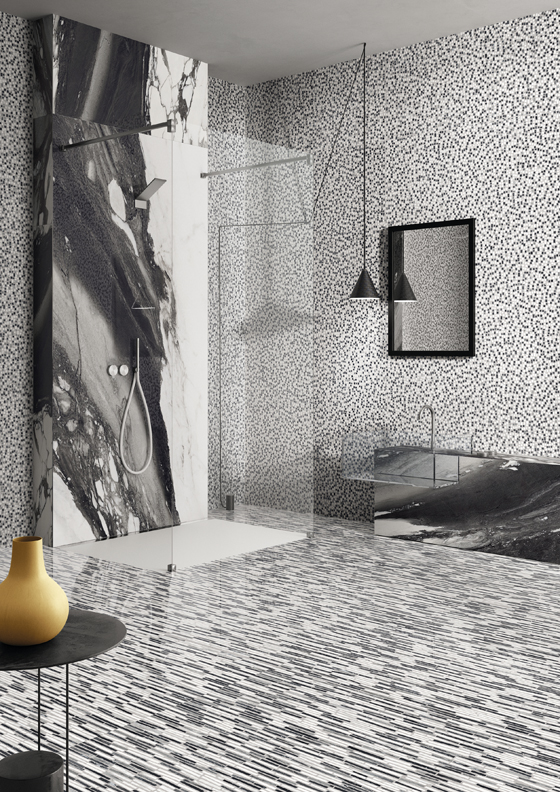Futures Past: Emilgroup
Brand story by Anna Winston
London, United Kingdom
06.03.18
A staunch commitment to R&D means EMILGROUP's stock-in-trade is as much innovation as it is the architectural ceramics its various brands produce.
Karman, one of 10 collections launched under the Emilgroup umbrella in the past year, combines technology and creativity to recreate the feeling of old materials in a new, contemporary context

Karman, one of 10 collections launched under the Emilgroup umbrella in the past year, combines technology and creativity to recreate the feeling of old materials in a new, contemporary context
×Innovation and tradition might not always seem like obvious bedfellows, but both are at the core of Italian architectural ceramics company Emilgroup and its four industry leading brands, Emilceramica, Ergon, Provenza and Viva.
“Research has always been at the heart of what we do,” explains Giancarlo Macchioni, director of Marketing and R&D at Emilgroup – a department known as “the creative workshop” within the company – and the man behind the most successful collections.
“The Emilgroup research center is a test-bed of encounters and cultural experiences out of which are born the collections of the four brands,” says Macchioni. “It is a synthesis of experimentation, creativity and performance.”
Top: Karman (Provenza) is available in finishes that mimic restored wood, smooth ceramics and concrete. Above: The Tele di Marmo collection is created by laying small dots and strips of marble into mortar

Top: Karman (Provenza) is available in finishes that mimic restored wood, smooth ceramics and concrete. Above: The Tele di Marmo collection is created by laying small dots and strips of marble into mortar
×Emilgroup’s oldest and perhaps best-known brand is Emilceramica. Founded in 1961, its name has kept the company connected to its Italian heritage – the original plan was to become the leading distributor of ceramic tiles through Italy’s Emilia region by creating stylish, luxurious and technologically supreme products for contemporary living. Its success would far surpass this ambition.
Today it has a number of production centres across Italy, and a huge international distribution network. The company rebranded as Emilgroup in 2016, creating an umbrella organisation that funds development across its four distinct brands. It invests over €4 million a year in research, and employs 30 technicians who focus on developing original ceramics processes and products.
In the last year alone, Emilgroup’s brands have launched more than 10 new collections. Each has been subjected to the same start-to-finish, obsessive attention to detail that typifies an Emilgroup product and ensures that they meet the highest performance criteria. But the company’s roots in the 20th century tradition of high-quality Italian design have not been abandoned in the name of progress and performance.
Tele di Marmo from Emilceramica aims to reinvent marble for contemporary interior design, with a series of installation options that create unusual textured patterns

Tele di Marmo from Emilceramica aims to reinvent marble for contemporary interior design, with a series of installation options that create unusual textured patterns
דWe are where material science meets artistic thinking,” reads the company’s mission statement. “We exist to enable people turn their creative vision into reality, transforming the world around us.”
The relationship between past and present, and between technology and creativity is epitomised in two of the storied company’s new collections: Karman by Provenza and Tele di Marmo by Emilceramica.
The idea behind Karman is to celebrate the notions of reinvention, recovery and restoration – of finding new value in the past. The textured ceramics in the collection reveal their true nature after being finished with a coating of resin, and come in a variety of sizes so that they can be used to create a total environment.
Each of the four different brands under the Emilgroup umbrella – Emilceramica, Provenza, Ergon and Viva – has its own identity and aesthetic, but they all share the same focus on design quality

Each of the four different brands under the Emilgroup umbrella – Emilceramica, Provenza, Ergon and Viva – has its own identity and aesthetic, but they all share the same focus on design quality
×The finishes suggest that the tiles have always been exactly where they are, and have settled into their place over time, while going beyond the technical performance requirements expected for architecture today.
”The latest trend in interior design is to recover original materials and spaces to bring them new life,” explains Macchioni. “So our aim is to recreate materials like wood, cement and ceramics with the effect of monochromatic resin.”
Tele di Marmo, meanwhile, reinvents the appearance of marble, shrugging off its classical associations to offer a strong aesthetic impact to almost any space.
Giancarlo Macchioni oversees research and development at Emilgroup, leading the way in creating innovative and aesthetically sensitive ceramics collections for dynamic architectural interiors

Giancarlo Macchioni oversees research and development at Emilgroup, leading the way in creating innovative and aesthetically sensitive ceramics collections for dynamic architectural interiors
×This modern approach to marble extends to the collection’s unconventional variety of slab sizes and tile arrangements, with almost invisible seams, making the collection extremely versatile. Designers can create an infinite number of designs by combining and contrasting the different pieces.
“The surfaces offer alternative installations of the marble slab portions: for example, the “seminato di tessere” or the “battuto di listelli” patterns, created by carefully laying tiny dots or rectangular marble strips in mortar,” says Macchioni. “The effect creates the most modern, unusual and dynamic surfaces.”
Karman and Tele di Marmo are just two examples out of many, but the message they project is clear. Emilgroup is looking to the future, but it won’t forget its past.
© Architonic










